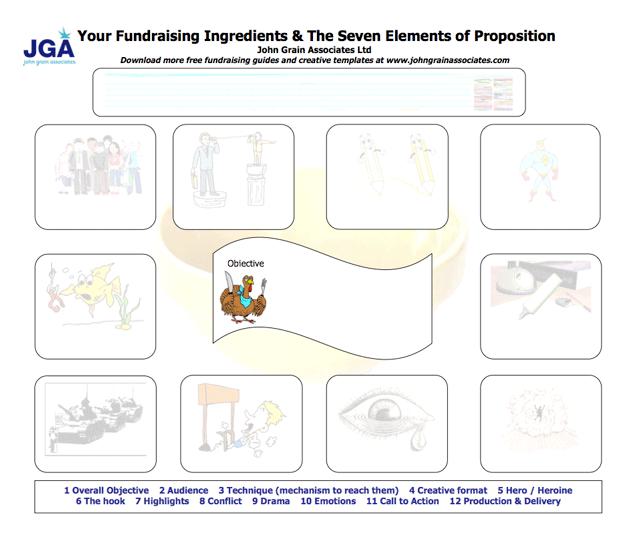The seven elements of proposition: how to get your story across
- Written by
- John Grain
- Added
- May 21, 2014

How you present your proposition to your audience is fundamental for gaining support. Whether it is a direct mail pack, a proposal, or a speech at an event it will be the power and impact of the story you tell that has the most lasting effect.
There are seven critical elements to remember when telling your story that will help make it compelling, engaging, effective and give you the best chance of success. Before preparing your material, try using this simple checklist and the exercises I’ve suggested, to ensure you have each element in place and working in your favour.
1. The protagonist
Like cars, stories need drivers, a hero that the audience can identify with and can believe in. Your protagonist should drive the action and tell your stories. They need to be honest and believable.
Exercise
Write down your protagonist’s name and three things that you know about her or him.
2. The hook
Like a good book, your story needs to hook your audience right from the start and grab their attention. Your story needs to begin where your audience can identify with the situation being described, with the hero of your story and with the goal or objective of your hero’s story. Most importantly, make it specific and make it real – a vague or fuzzy opening is likely to lose your readers before they’ve really begun.
Exercise
Write down your opening three sentences. Don’t worry about copywriting skills at this stage; remember you are just trying to grab somebody’s attention.
3. Keep it interesting
Predictable is boring. This is where you should be pushing your unique selling point (USP) – what it is that makes you different or better than the competition. If possible, throw in some barriers or surprises to the main body of your story, which will keep your audience’s attention and maintain their interest. It is good to use humour if appropriate or relevant.
Remember too, that numbers numb and jargon jars. No one ever marched on Westminster because of a pie chart, so keep statistics to a minimum and only use them if they are very powerful and add something essential to the story.
Exercise
Write down three highlights of your story, which will engage and keep your audience’s attention.
4. The conflict
There is no drama without conflict. Heroism is heightened and made more compelling when juxtaposed against some kind of villainy or obstacle. Your story has to contain an element of good versus bad or a struggle to overcome great odds.
Exercise
Describe your enemy; is it a person, an organisation, exclusion, poverty, a disease or illness of some kind and if so, what kind?
5. The telling details
Brevity should be your God and you must worship at the altar of conciseness. Pick a few telling details or highlights that bring your story to life and vividly paint the picture of the world you are describing.
Exercise
Write down two or three things that your hero has to overcome to succeed or two or three things your hero has achieved in the face of adversity.
6. Emotions
Your audience is giving you their time and attention – a precious commodity. So, make sure you do more than just recite the facts; make it an emotional experience that makes their time worthwhile. You need to make them really feel something and make them understand, empathise and care about your hero, your cause and your story.
Exercise
Write an emotional anecdote from the life of your hero. Then write five words to describe how your audience will feel after reading or hearing the anecdote.
7. Call to action
You should be giving your audience a story, not just information, and it must convince the audience of what part they have to play and how they fit in. Make it clear what is it you want them to do and why it is urgent. You want them to act now, not come back to you later.
Exercise
Write down the single, main action you want your audience to take after hearing or reading your story. Then write down three (or more) reasons why your story will make them do it.
And don’t forget…
Although these seven elements are crucial, they will not work without the other main ingredients in place.
- Objective – do you know exactly what outcome you are after? (Raising money, taking part in a campaign, invitation to an event, communicating your brand message, launching a service.)
- Audience – are you going to the right people at the right time with the right story?
- Technique – are you using the right medium or channel to reach your audience? (Sending a text message to an elderly donor is not likely to be hugely successful.)
- Creative – does it look good, grab the attention, and portray your story accurately?
- Production – is the timing right, has the copy been approved and proofed? When will it reach your audience?
Good luck with telling your story!
John Grain Associates Ltd. 2011

















